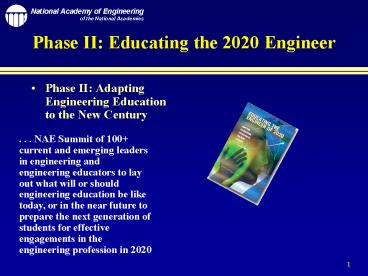Phase II: Educating the 2020 Engineer - PowerPoint PPT Presentation
1 / 19
Title:
Phase II: Educating the 2020 Engineer
Description:
Phase II: Educating the 2020 Engineer Phase II: Adapting Engineering Education to the New Century. . . NAE Summit of 100+ current and emerging leaders in engineering ... – PowerPoint PPT presentation
Number of Views:160
Avg rating:3.0/5.0
Title: Phase II: Educating the 2020 Engineer
1
Phase II Educating the 2020 Engineer
- Phase II Adapting Engineering Education to the
New Century
. . . NAE Summit of 100 current and emerging
leaders in engineering and engineering educators
to lay out what will or should engineering
education be like today, or in the near future to
prepare the next generation of students for
effective engagements in the engineering
profession in 2020
2
Characteristics of the 2020 Engineer
- Technically proficient
- Innovative
- Broadly Educated
- Flexible
- Ethically grounded
- Prepared to work in a rapidly changing global
economy
3
Characteristics of the 2020 Engineer
- Prepared to contend with emerging advances such
as biotechnology, nanotechnology, information and
communications technology, material science,
Photonics and other unanticipated technologies - Possessing a systems perspective to enable
collaboration with multidisciplinary teams of
technical experts - Able to communicate with technical and public
audiences - Able to communicate using technology and an
understanding of the complexities associated with
a global market and social context
4
Guiding Strategies from the Phase II Summit
- Engage in a comprehensive examination of the
system of systems of engineering education. - Focus on levers for change.
- Pursue student-centered education.
- Develop engineering education research base.
- Communicate, Communicate, Communicate
5
System of Systems Review
- The teaching, learning and assessment processes
that move a student from one state of knowledge
to another state - Student and teacher/faculty as primary actors
within the learning process - Curriculum, laboratories, instructional
technologies, and other tools for teaching and
learning
6
System of Systems Review
- Goals and objectives of teachers/faculty,
departments, colleges, accreditors, employers,
and other stakeholders of engineering education - The external environment that shapes the overall
demand for engineering education - A process of revising goals and objectives as
technological advances and other changes occur
7
Focus on Levers for Change
- Professional Societies
- Engineering Faculty
- Students
- Others whose perspectives, imagination and
energies can help in designing, implementing and
assessing systems changes to create desired
outcomes
8
Pursue Student-Centered Education
- Address how students learn as well as what they
learn in order to ensure that student learning
outcomes focus on the performance characteristics
needed in future engineers - Better alignment of curriculum
- Better alignment of faculty skill set with those
needed to deliver the desired curriculum in light
of the different learning styles of students
9
Develop Research Base
- Conduct research on how students learn
engineering to address issues related to
broadening participation, improving retention of
majors, creating courses for non-majors and
designing an alternative engineering degree for
students interested in careers and public service
opportunities outside traditional engineering
employment
10
Communicate, Communicate, Communicate
- To increase public awareness and understanding of
engineering - Its social context and how engineering makes
contributions to our quality of life - The values of engineering training for a variety
of tasks/challenges - Its breadth and depth and expanding options
11
Selected Recommendations
Educating the Engineer of 2020 Adapting Engineeri
ng Education to the New Century
12
Recommendation
- Whatever other creative approaches are taken in
the 4-year engineering curriculum, the essence of
engineering - the iterative process of
designing, building, and testing - should be
taught from the earliest stages of the
curriculum, including the first year.
13
First Year Engineering Projects
Source Knight, D. W., L. E. Carlson, and J. F.
Sullivan. 2003. Staying in engineering Impact of
a hands-on, team based, First-Year Projects
course on student retention. In Proceedings of
the 2003 American Society for Engineering
Education Annual Conference Exposition.
Washington, DC American Society for Engineering
Education.
14
Recommendation
- The engineering education establishment should
embrace research in engineering education as a
valued activity for engineering faculty as a
means to enhance and personalize the connection
to undergraduate students, to understand how they
learn and to appreciate the pedagogical
approaches that excite them.
15
Recommendation
- Four-year engineering schools must accept it as
their responsibility to work with their local
community colleges to ensure effective
articulation, as seamless as possible, with their
two-year programs.
16
Recommendations
- The engineering education establishment should
participate in a coordinated national effort to
promote public understanding of engineering and
technology literacy of the public. - Engineering schools and employers of engineers
should lend their energies to a national effort
to improving math, science, and engineering
education at the K-12 level.
17
Recommendations
- Though not addressed specifically in the report,
the opportunity exists for engineers and
engineering schools to enhance the ability of
schools to prepare students for STEM disciplines
by partnering with schools of education on
in-service and pre-service education and training
programs and by engaging in outreach activities
in the community.
18
Guideposts for the Future
- Collaborations
- NSF Funded Coalitions
- Grand Challenges
- Programs sparked by industry, foundations and/or
professional societies
19
Guideposts for the Future
- Technologies for Collaborations
- Electronic technologies that enable sharing of
ideas, materials, and other resources relating to
the transformation of individual courses or labs,
departments, programs or institutions
20
Engineer of 2020 Initiative Purdue Univ.































